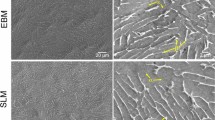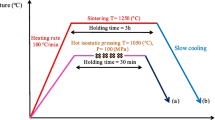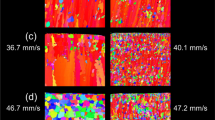Abstract
One of the most recent methods for fabricating titanium-based products is metal injection molding (MIM). However, there have been few systematic studies on the definition and generation mechanism of surface porosity of MIM Ti–6Al–4V and its relationship with powder, process, and mechanical performances so far. In this article, MIM was selected to produce Ti–6Al–4V, and the investigation aimed to determine the impact of the sintering and subsequent hot isostatic pressing (HIP) process on its microstructure and mechanical performances. The results indicate that Ti–6Al–4V alloy formed a dense layer after sintering because of the temperature gradient from surface to core. The thickness of dense layer, grain size, grain morphology, and grain orientation are the key factors that determine Ti–6Al–4V alloy’s mechanical performances. Under the condition of sintering at 1000 ℃ with HIP process, Ti–6Al–4V alloy formed a dense layer with a thickness of 290 µm, equiaxed grains with an average grain size of 16 µm, and a significant number of high-angle grain boundaries (88.9%). The optimized microstructure of Ti–6Al–4V led to outstanding mechanical performances, exhibiting tensile strength of 1067 MPa, yield strength of 997 MPa, and elongation of 17.5%. Other MIM materials can also be guided by this approach.










Similar content being viewed by others
References
Moghadam MS, Fayyaz A, Ardestani M (2021) Fabrication of titanium components by low-pressure powder injection moulding using hydride-dehydride titanium powder. Powder Technol 377:70–79. https://doi.org/10.1016/j.powtec.2020.08.075
Zakaria MY, Sulong AB, Muhamad N, Ramli MI (2019) Rheological properties of titanium-hydroxyapatite with powder space holder composite feedstock for powder injection moulding. Int J Adv Manuf Technol 102:2591–2599. https://doi.org/10.1007/s00170-018-03264-y
Suwanpreecha C, Alabort E, Tang YB, Panwisawas C, Reed RC, Manonukul A (2021) A novel low-modulus titanium alloy for biomedical applications: a comparison between selective laser melting and metal injection moulding. Mater Sci Eng A 812:141081. https://doi.org/10.1016/j.msea.2021.141081
Wang FB, Wang YQ (2021) Cleaner milling on Ti-6Al-4V alloy cooled by liquid nitrogen: external spray and inner injection. Int J Adv Manuf Technol 112:1193–1206. https://doi.org/10.1007/s00170-020-06440-1
Liang XL, Liu ZQ (2018) Tool wear behaviors and corresponding machined surface topography during high-speed machining of Ti-6Al-4V with fine grain tools. Tribol Int 121:321–332. https://doi.org/10.1016/j.triboint.2018.01.057
Liang XL, Liu ZQ, Liu WT, Wang B, Yao GH (2019) Surface integrity analysis for high-pressure jet assisted machined Ti-6Al-4V considering cooling pressures and injection positions. J Manuf Process 40:149–159. https://doi.org/10.1016/j.jmapro.2019.03.020
Sheppard B, Shaw C, Williams B, Persaud J, Bromberger J (2014) Factory of the future. McKinsey& Company 1–32.
Xu P, Pyczak F, Limberg W, Willumeit-Römer R, Ebel T (2021) Superior fatigue endurance exempt from high processing cleanliness of metal-injection-molded β Ti-Nb-Zr for bio-tolerant applications. Mater Des 211:110141. https://doi.org/10.1016/j.matdes.2021.110141
Mahmud NN, Azam FAA, Ramli MI, Foudzi FM, Ameyama K, Sulong AB (2021) Rheological properties of irregular-shaped titanium-hydroxyapatite bimodal powder composite moulded by powder injection moulding. J Mater Res Technol 11:2255–2264. https://doi.org/10.1016/j.jmrt.2021.02.016
Hamidi MFFA, Harun WSW, Samykano M, Ghani SAC, Ghazalli Z, Ahmad F, Sulong AB (2017) A review of biocompatible metal injection moulding process parameters for biomedical applications. Mater Sci Eng C 78:1263–1276. https://doi.org/10.1016/j.msec.2017.05.016
Bootchai S, Taweejun N, Manonukul A, Kanchanomai C (2020) Metal injection molded titanium: mechanical properties of debinded powder and sintered metal. J Mater Eng Perform 29:4559–4568. https://doi.org/10.1007/s11665-020-04970-z
Subaşıa M, Safarian A, Karataş Ç (2019) An investigation on characteristics and rheological behaviour of titanium injection moulding feedstocks with thermoplastic-based binders. Powder Metall. 62:229–239. https://doi.org/10.1080/00325899.2019.1635305
Subaşi M, Safarian A, Karataş Ç (2019) The investigation of production parameters of Ti-6Al-4V component by powder injection molding. Int J Adv Manuf Technol 105:4747–4760. https://doi.org/10.1007/s00170-019-04514-3
Waalkes L, Längerich J, Imgrund P, Emmelmann C (2022) Piston-based material extrusion of Ti-6Al-4V feedstock for complementary use in metal injection molding. Materials 15:351. https://doi.org/10.3390/ma15010351
Sun Y, Luo GQ, Zhang J, Wu CD, Li J, Shen Q, Zhang LM (2018) Phase transition, microstructure and mechanical properties of TC4 titanium alloy prepared by plasma activated sintering. J Alloy Compd 741:918–926. https://doi.org/10.1016/j.jallcom.2018.01.197
Hayat MD, Zhang HZ, Karumbaiah KM, Singh H, Xu Y, Zou LM, Qu XH, Ray S, Cao P (2021) A novel PEG/PMMA based binder composition for void-free metal injection moulding of Ti components. Powder Technol 382:431–440. https://doi.org/10.1016/j.powtec.2021.01.009
Hu K, Zou LM, Shi Q, Hu K, Liu X, Duan BH (2020) Effect of titanium hydride powder addition on microstructure and properties of titanium powder injection molding. Powder Technol 367:225–232. https://doi.org/10.1016/j.powtec.2020.03.059
German RM (2019) The evolution of powder injection moulding: past perspectives and future growth. Powder Injection Moulding Int 13:57–66
Ebel T, Blawert C, Willumeit R, Luthringer BJC, Ferri OM, Feyerabend F (2011) Ti-6Al-4V-0.5B–a modified alloy for implants produced by metal injection molding. Adv Eng Mater 13:B440–B453. https://doi.org/10.1002/adem.201180017
Ebel T (2019) Metal injection molding (MIM) of titanium and titanium alloys. In: Heaney DF (ed) Handbook of metal injection molding. Woodhead Publishing, Sawston, pp 431–460
Soyama J, Ferri OM, Ebel T, Kainer KU (2016) Axial fatigue testing of Ti–6Al–4V using an alternative specimen geometry fabricated by metal injection moulding. Powder Metall 59:344–349. https://doi.org/10.1080/00325899.2016.1251060
Heaney DF, Binet C (2019) Hot isostatic pressing (HIP) of metal injection molding (MIM). In: Heaney DF (ed) Handbook of metal injection molding. Woodhead Publishing, Sawston, pp195–202
Dehghan-Manshadi A, Bermingham MJ, Dargusch MS, StJohn DH, Qian M (2017) Metal injection moulding of titanium and titanium alloys: challenges and recent development. Powder Technol 319:289–301. https://doi.org/10.1016/j.powtec.2017.06.053
Cao GY, Deng ZY, Ren L, Li YJ (2013) Research on determination method of measuring the best powder loading of powder injection molding. New Technology & New Process 3:49–51
Oghbaei M, Mirzaee O (2010) Microwave versus conventional sintering: a review of fundamentals, advantages and applications. J Alloy Compd 494:175–189. https://doi.org/10.1016/j.jallcom.2010.01.068
Sidambe AT, Figueroa IA, Hamilton HGC, Todd I (2012) Metal injection moulding of CP-Ti components for biomedical applications. J Mater Process Technol 212:1591–1597. https://doi.org/10.1016/j.jmatprotec.2012.03.001
Horke K, Ruderer B, Singer RF (2014) Influence of sintering conditions on tensile and high cycle fatigue behaviour of powder injection moulded Ti–6Al–4V at ambient and elevated temperatures. Powder Metall 57:283–290. https://doi.org/10.1179/1743290114Y.0000000102
Ivasishin OM, Eylon D, Bondarchuk VI, Savvakin DG (2008) Diffusion during powder metallurgy synthesis of titanium alloys. Defect Diffus 277:177–185. https://doi.org/10.4028/www.scientific.net/DDF.277.177
Dekhtyar AI, Bondarchuk VI, Nevdacha VV, Kotko AV (2020) The effect of microstructure on porosity healing mechanism of powder near-β titanium alloys under hot isostatic pressing in α + β-region: Ti-10V-2Fe-3Al. Mater Charact 165:110393. https://doi.org/10.1016/j.matchar.2020.110393
Choi BJ, Lee S, Kim YJ (2014) Alpha-case reduction mechanism of titanium powder-added investment molds for titanium casting. J Mater Eng Perform 23:1415–1423. https://doi.org/10.1007/s11665-013-0859-6
Feng YJ, Zhang WC, Zeng L, Cui GR, Chen WZ (2017) Room-temperature and high-temperature tensile mechanical properties of TA15 titanium alloy and TiB whisker-reinforced TA15 matrix composites fabricated by vacuum hot-pressing sintering. Materials 10:424. https://doi.org/10.3390/ma10040424
Machio C, Mathabathe MN, Bolokang AS (2020) A comparison of the microstructures, thermal and mechanical properties of pressed and sintered Ti-Cu, Ti-Ni and Ti-Cu-Ni alloys intended for dental applications. J Alloy Compd 848:156494. https://doi.org/10.1016/j.jallcom.2020.156494
Zhao DP, Chang KK, Ebel T, Qian M, Willumeit R, Yan M, Pyczak F (2013) Microstructure and mechanical behavior of metal injection moulded Ti-Nb binary alloys as biomedical material. J Mech Behav Biomed Mater 28:171–182. https://doi.org/10.1016/j.jmbbm.2013.08.013
Obasi GC, Ferri OM, Ebel T, Bormann R (2010) Influence of processing parameters on mechanical properties of Ti–6Al–4V alloy fabricated by MIM. Mater Sci Eng A 527:3929–3935. https://doi.org/10.1016/j.msea.2010.02.070
Kafkas F, Ebel T (2014) Metallurgical and mechanical properties of Ti–24Nb–4Zr–8Sn alloy fabricated by metal injection molding. J Alloy Compd 617:359–366. https://doi.org/10.1016/j.jallcom.2014.07.168
Zhao DP, Chang KK, Ebel T, Qian M, Willumeit R, Yan M, Pyczak F (2014) Titanium carbide precipitation in Ti–22Nb alloy fabricated by metal injection moulding. Powder Metall 57:2–4. https://doi.org/10.1179/0032589914Z.000000000153
Cho K, Niinomi M, Nakai M, Liu HH, Santos PF, Itoh Y, Ikeda M, Gepreel MA, Narushima T (2016) Improvement in mechanical strength of low-cost β-type Ti-Mn alloys fabricated by metal injection molding through cold rolling. J Alloy Compd 664:272–283. https://doi.org/10.1016/j.jallcom.2015.12.200
Nor NHM, Muhamad N, Ihsan AKAM, Jamaludin KR (2013) Sintering parameter optimization of Ti-6Al-4V metal injection molding for highest strength using palm stearin binder. Procedia Engineering 68:359–364. https://doi.org/10.1016/j.proeng.2013.12.192
Lin DG, Kang TG, Han JS, Park SJ, Chung ST, Kwon YS (2018) Experimental and numerical analysis of injection molding of Ti-6Al-4V powders for high-performance titanium parts. JOM-J Miner Met Mater Soc 70:621–625. https://doi.org/10.1007/s11837-018-2786-3
Zhang C, Pan Y, Sun JZ, Lu XD (2021) A net-shape forming process of Ti-6Al-4V sphere joints. Powder Metall 64:1–8. https://doi.org/10.1080/00325899.2021.1924479
Kudo K, Shinagawa K, Miura H (2018) Effect of α + β region sintering on the mechanical properties of injection molded Ti-6Al-4V compacts. Mech Eng J 5:17–00686. https://doi.org/10.1299/mej.17-00686
Funding
The National Key Research and Development Program of China (grant number 2021YFB3701900) and the Fundamental Research Funds for the Central Universities (grant number 226–2022-00123) provided support for this work.
Author information
Authors and Affiliations
Contributions
Conceptualization and design of the study were contributed by all authors. Shaohua Su, Peng Wang, Xiaobao Li, and Yuhui Huang prepared the materials, collected the data, and analyzed the results. Shaohua Su was responsible for crafting the initial draft, and all co-authors offered their thoughts and suggestions on previous revisions. All authors have given their endorsement to the ultimate version.
Corresponding authors
Ethics declarations
Competing interests
The authors declare no competing interests.
Additional information
Publisher's note
Springer Nature remains neutral with regard to jurisdictional claims in published maps and institutional affiliations.
Rights and permissions
Springer Nature or its licensor (e.g. a society or other partner) holds exclusive rights to this article under a publishing agreement with the author(s) or other rightsholder(s); author self-archiving of the accepted manuscript version of this article is solely governed by the terms of such publishing agreement and applicable law.
About this article
Cite this article
Su, S., Hong, Z., Wu, Y. et al. Dense layer, microstructure, and mechanical performances of Ti–6Al–4V alloy prepared by metal injection molding. Int J Adv Manuf Technol 126, 3861–3871 (2023). https://doi.org/10.1007/s00170-023-11376-3
Received:
Accepted:
Published:
Issue Date:
DOI: https://doi.org/10.1007/s00170-023-11376-3




